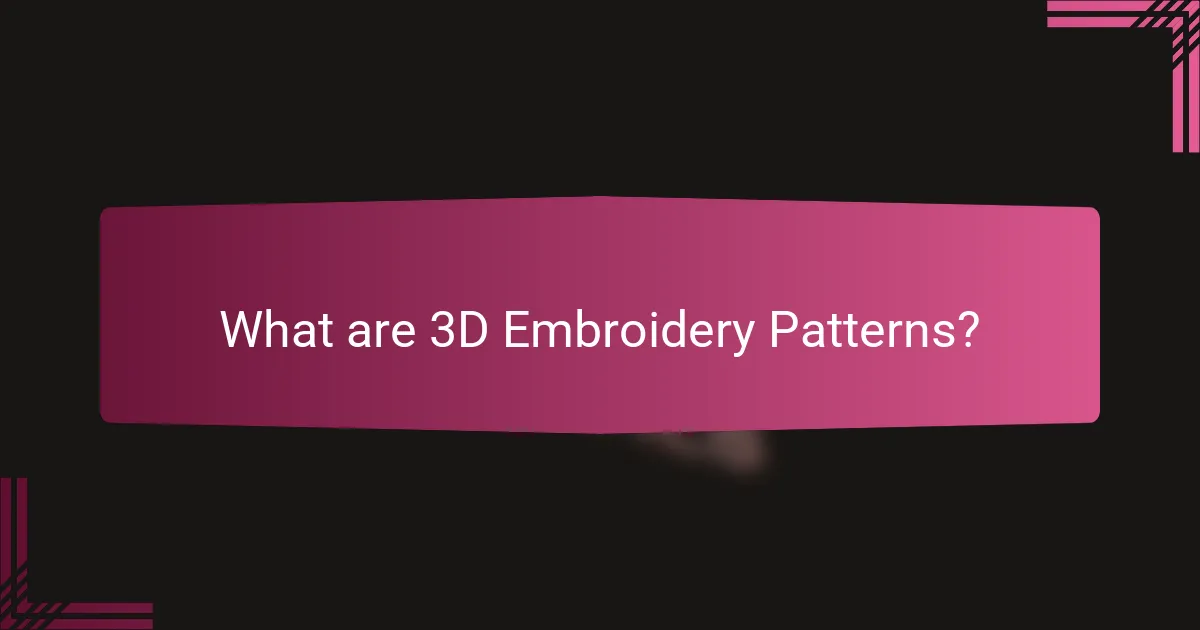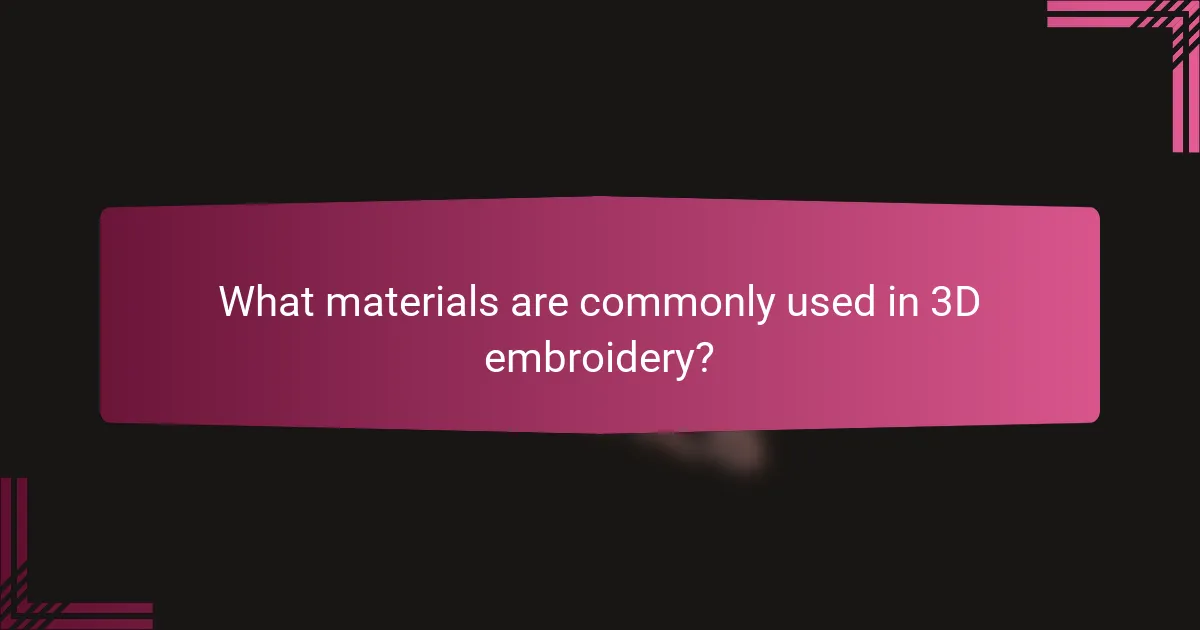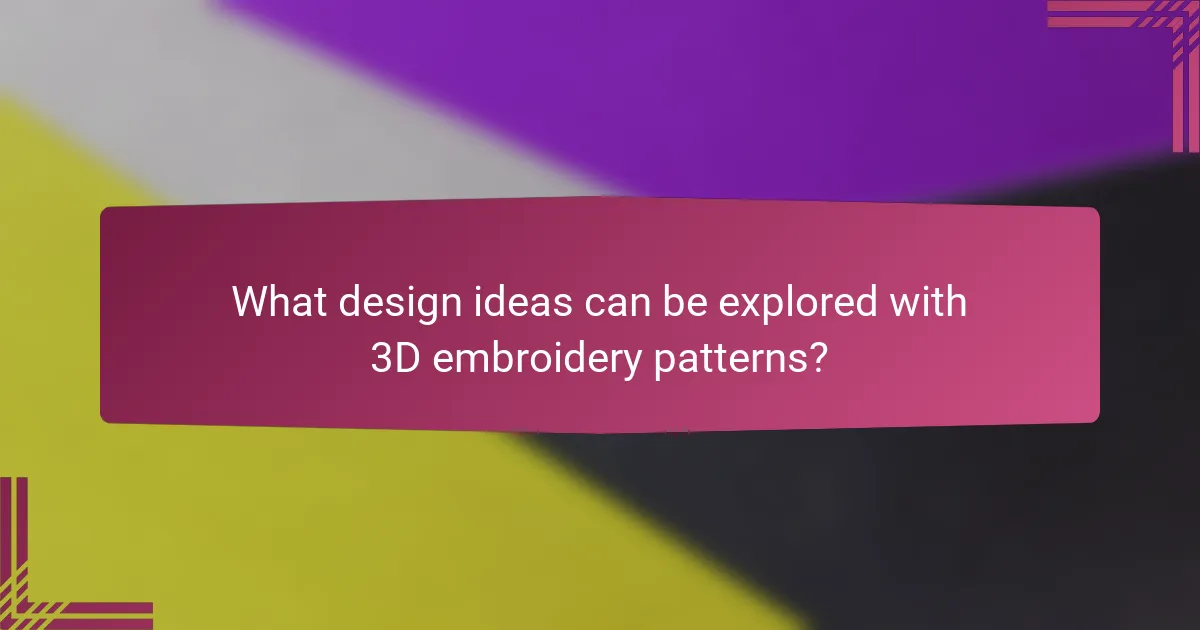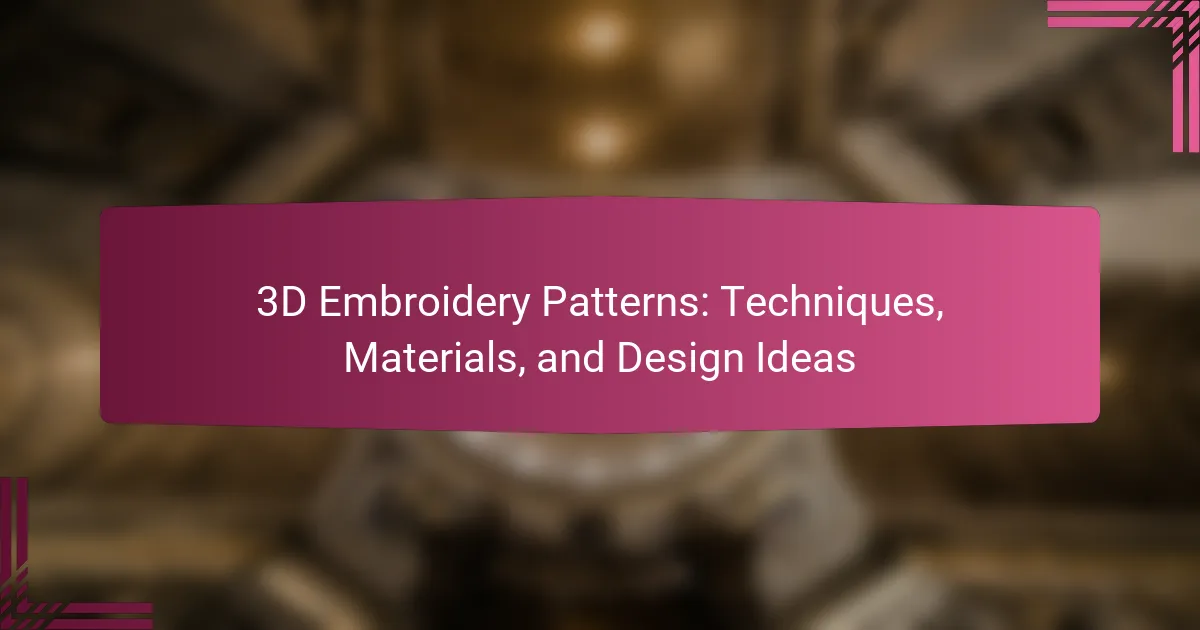
What are 3D Embroidery Patterns?
3D embroidery patterns are designs that create a three-dimensional effect on fabric. These patterns use various techniques to add depth and texture. Common methods include layering threads and using specialty stitches. The result is a raised, tactile surface that enhances visual appeal. Materials often used include thicker threads and foam for added volume. 3D embroidery is popular in fashion and promotional items. It allows for intricate designs that stand out. The technique has gained traction due to advancements in embroidery machines.
How are 3D embroidery patterns created?
3D embroidery patterns are created using specialized embroidery techniques that add depth and dimension. The process often involves layering stitches to create a raised effect. Common methods include using foam, felt, or specialty threads. Digitizing software is used to design the patterns before stitching. This software allows for precise control over stitch placement and density. The embroidery machine follows the digitized design to produce the pattern. The result is a textured appearance that stands out from traditional flat embroidery. Techniques like puff embroidery are specifically designed for this purpose.
What techniques are used in creating 3D embroidery patterns?
Techniques used in creating 3D embroidery patterns include layering, padding, and using specialty threads. Layering involves stitching multiple layers of fabric or thread to create depth. Padding adds volume by incorporating foam or other materials beneath the stitches. Specialty threads, such as metallic or textured types, enhance the visual effect. Additionally, techniques like appliqué and trapunto can be utilized for more intricate designs. Each of these methods contributes to the overall three-dimensional appearance of the embroidery.
What tools and equipment are essential for 3D embroidery?
Essential tools and equipment for 3D embroidery include an embroidery machine, specialty threads, and stabilizers. An embroidery machine is necessary for creating intricate designs. Specialty threads, such as foam or raised threads, add dimension to the embroidery. Stabilizers provide support to the fabric during the embroidery process. Additionally, embroidery hoops help secure the fabric in place. Scissors are needed for trimming excess threads. A digitizing software is crucial for converting designs into machine-readable formats. These tools collectively enable the effective creation of 3D embroidered designs.
What are the benefits of using 3D embroidery patterns?
3D embroidery patterns enhance the visual appeal of textile designs. They create a raised effect, adding depth and texture to the fabric. This technique allows for intricate detailing that flat embroidery cannot achieve. 3D patterns can attract attention and stand out in a competitive market. They are often used in branding to make logos more memorable. Additionally, 3D embroidery is durable, maintaining its appearance even after multiple washes. This longevity makes it a cost-effective choice for businesses and consumers alike. The use of various materials further expands design possibilities, enabling unique creations tailored to specific themes or events.
How do 3D embroidery patterns enhance design aesthetics?
3D embroidery patterns enhance design aesthetics by adding depth and texture to the fabric. This dimensionality creates visual interest that flat designs cannot achieve. The raised elements draw the eye, making the piece more engaging. Additionally, these patterns can highlight intricate details that enhance the overall design. The use of various thread colors and materials can create contrasting effects, further elevating the aesthetic appeal. According to a study by the Textile Research Journal, 3D embroidery techniques can increase perceived value in fashion items. This added value can lead to higher consumer interest and sales.
What practical applications exist for 3D embroidery patterns?
3D embroidery patterns have various practical applications. They are used in fashion design to create textured garments. This technique enhances visual appeal and adds depth to clothing. Home décor items often feature 3D embroidery for unique designs. Pillows, wall hangings, and table linens benefit from this intricate style. Promotional products utilize 3D embroidery to elevate branding on apparel. Companies often choose this method for logos on uniforms and caps. Additionally, 3D embroidery is popular in costume design for theatrical productions. It allows for detailed embellishments that enhance character portrayal.

What materials are commonly used in 3D embroidery?
Common materials used in 3D embroidery include foam, specialty threads, and stabilizers. Foam provides the raised effect characteristic of 3D embroidery. Specialty threads, such as polyester or metallic, enhance the visual appeal. Stabilizers are essential for supporting the fabric during stitching. These materials work together to create dimensional designs. The combination of these components ensures durability and quality in the final product.
How do different materials impact the quality of 3D embroidery?
Different materials significantly impact the quality of 3D embroidery. The choice of fabric affects how well the embroidery stands out. For instance, thicker fabrics can support raised designs better than thinner ones. Additionally, the type of thread used influences durability and sheen. Polyester threads provide vibrant colors and are resistant to fading. Cotton threads, while softer, may not hold their shape as well. The backing material also plays a crucial role in stabilizing the fabric during the embroidery process. A sturdy backing prevents distortion and ensures a clean finish. Ultimately, selecting the right combination of materials enhances the overall appearance and longevity of 3D embroidery.
What are the best fabrics for 3D embroidery patterns?
The best fabrics for 3D embroidery patterns include cotton, polyester, and denim. Cotton is versatile and provides a smooth surface for detailed embroidery. Polyester is durable and resistant to fading, making it ideal for vibrant designs. Denim offers a sturdy base that enhances the texture of 3D embroidery. These fabrics allow for effective stitching and maintain the dimensional quality of the patterns. Additionally, they support various thread types, ensuring the embroidery stands out.
What threads and stabilizers are recommended for 3D embroidery?
For 3D embroidery, polyester threads are recommended due to their durability and sheen. Rayon threads can also be used for their vibrant colors and smooth finish. Stabilizers play a crucial role in achieving quality results. Cut-away stabilizers are preferred for their ability to support dense stitching. Tear-away stabilizers can be used for lighter designs. Using the right combination of threads and stabilizers ensures clean and professional-looking 3D embroidery.
What innovative materials are emerging in 3D embroidery?
Innovative materials emerging in 3D embroidery include thermoplastic polyurethane (TPU) and silicone-based threads. TPU offers flexibility and durability, making it suitable for intricate designs. Silicone-based threads provide a unique texture and enhance the tactile quality of embroidered pieces. Additionally, conductive threads are gaining traction for creating smart textiles. These materials allow for the integration of technology into embroidery, expanding its applications. Research has shown that these innovative materials can significantly enhance the aesthetic and functional aspects of 3D embroidery.
How do these materials differ from traditional options?
3D embroidery materials differ from traditional options primarily in their texture and dimensionality. Traditional embroidery typically utilizes flat threads and fabrics, resulting in a two-dimensional appearance. In contrast, 3D embroidery employs specialized threads and techniques that create raised designs. This adds depth and visual interest to the embroidered patterns. Additionally, 3D materials often include foam or other padding, enhancing the tactile experience. Research indicates that 3D embroidery can improve the durability and longevity of designs compared to traditional methods. Furthermore, the use of advanced technology in 3D embroidery allows for more intricate and complex patterns.
What advantages do new materials offer in 3D embroidery?
New materials in 3D embroidery enhance durability and flexibility. These materials often include advanced polymers and specialty threads. They provide improved texture and depth to designs. New materials also allow for intricate detailing that was previously difficult to achieve. Additionally, they can reduce production time due to easier handling and application. Enhanced color retention is another benefit, ensuring vibrant designs over time. These advancements lead to increased creative possibilities for designers. Overall, new materials significantly elevate the quality and efficiency of 3D embroidery projects.

What design ideas can be explored with 3D embroidery patterns?
3D embroidery patterns can explore various design ideas such as floral motifs, geometric shapes, and textured landscapes. Floral motifs can create depth and dimension, enhancing visual appeal. Geometric shapes offer a modern aesthetic, allowing for intricate designs. Textured landscapes can simulate natural elements, adding realism to the embroidery. These ideas leverage the dimensional capabilities of 3D embroidery techniques. Popular applications include fashion, home decor, and promotional items. The versatility of 3D embroidery enables unique customization options, catering to diverse artistic preferences.
What themes are popular in 3D embroidery design?
Floral designs are popular themes in 3D embroidery. These designs often feature intricate petals and leaves that create depth. Nature-inspired motifs are also favored, showcasing animals and landscapes. Geometric patterns provide a modern touch with their structured shapes. Cultural symbols represent heritage and identity in unique ways. Abstract art themes allow for creative expression through unconventional forms. Seasonal themes reflect the changing times, such as winter or spring motifs. Each of these themes enhances the visual appeal of 3D embroidery projects.
How can seasonal themes be incorporated into 3D embroidery?
Seasonal themes can be incorporated into 3D embroidery by using specific colors, motifs, and designs that reflect each season. For spring, floral patterns and pastel colors can evoke freshness. Summer themes may include bright colors and sun or beach motifs. Autumn can be represented with warm hues and leaf designs. Winter themes often feature cool colors and snowflake or holiday motifs. The choice of thread type can also enhance the seasonal feel, with shiny threads for summer and textured threads for winter. Additionally, layering techniques in 3D embroidery can create depth, making seasonal elements more visually engaging.
What are some unique design concepts for 3D embroidery?
Unique design concepts for 3D embroidery include layered textures, dimensional shapes, and intricate patterns. Layered textures create depth by combining different stitch types and heights. Dimensional shapes can be achieved through puff embroidery, which raises the design off the fabric. Intricate patterns often feature floral or geometric designs that pop through the use of contrasting thread colors. Other concepts include using metallic threads for a shiny effect and incorporating appliqué elements for added dimension. These techniques enhance visual appeal and create unique textile art.
How can beginners start with 3D embroidery design?
Beginners can start with 3D embroidery design by selecting suitable materials and tools. Essential tools include an embroidery machine capable of 3D effects, stabilizers, and threads. Choosing the right stabilizer is crucial for maintaining fabric integrity during stitching. Beginners should also learn basic embroidery techniques, such as digitizing designs for 3D effects. Familiarizing themselves with software like Wilcom or Hatch can enhance design capabilities. Practicing on simple designs helps build confidence and skill. Engaging with online tutorials and communities can provide valuable insights and support. Starting with a few basic patterns allows beginners to understand the process before advancing to complex designs.
What tips and tricks can help beginners succeed in 3D embroidery?
To succeed in 3D embroidery, beginners should focus on proper stabilizer use. A good stabilizer prevents fabric distortion during stitching. Choose a tear-away or cut-away stabilizer based on the fabric type. Beginners should also select the right thread; high-quality embroidery thread enhances stitch appearance. Using a hoop is essential to keep the fabric taut. This prevents puckering and ensures even stitching. Practice with simple designs before attempting complex patterns. This builds confidence and skill gradually. Regularly cleaning the machine helps maintain performance and stitch quality. Lastly, reviewing online tutorials can provide valuable insights and techniques.
What common mistakes should beginners avoid in 3D embroidery?
Beginners in 3D embroidery should avoid several common mistakes. One mistake is not stabilizing the fabric properly. Proper stabilization prevents distortion during stitching. Another mistake is using the wrong thread type. Using inappropriate thread can lead to poor quality and breakage. Beginners often neglect to test their designs before the final project. Testing helps identify issues early on. Additionally, improper hooping can cause uneven stitching. Correct hooping ensures that the fabric remains taut. Beginners sometimes overlook the importance of needle selection. Using the wrong needle can affect the stitch quality. Lastly, failing to clean the machine regularly can lead to malfunctions. Regular maintenance keeps the machine in optimal condition. These mistakes can hinder the quality of 3D embroidery projects.
3D embroidery patterns are designs that create a three-dimensional effect on fabric through techniques like layering threads and using specialty stitches. This article covers the creation process, essential tools, and materials used in 3D embroidery, such as foam and specialty threads. It also explores the benefits of 3D patterns, including enhanced visual appeal and durability, as well as popular design themes and innovative materials. Additionally, practical applications in fashion, home décor, and branding are discussed, along with tips for beginners to successfully engage in 3D embroidery projects.
